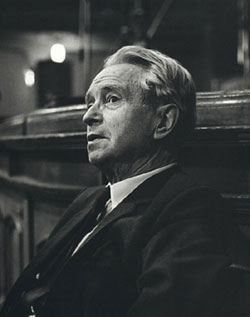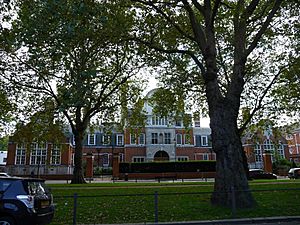Herbert Howells facts for kids
Quick facts for kids
Herbert Howells
|
|
|---|---|
 |
|
| Born | 17 October 1892 Lydney, Gloucestershire, England
|
| Died | 23 February 1983 (aged 90) Putney, London, England
|
| Occupation |
|
| Spouse(s) |
Dorothy Dawe (1891–1975)
(m. 1920–1975) |
| Children | 2, including Ursula |
Herbert Norman Howells (born October 17, 1892 – died February 23, 1983) was a famous English composer, organist, and teacher. He is best known for writing a lot of Anglican church music, which is music for church services.
Contents
Life of a Composer
Early Life and Musical Start

Herbert Howells was born in Lydney, England. He was the youngest of six children. His father, Oliver Howells, was a plumber and also played the organ at the local Baptist church.
Herbert showed musical talent very early. He started helping his father play the organ. By age eleven, he was a choirboy and unofficial assistant organist at the local Church of England.
His family faced tough financial times. In 1904, when Herbert was almost 12, his father went bankrupt. This was a very difficult time for the family.
But Herbert was lucky! A kind family, related to Charles Bathurst, 1st Viscount Bledisloe, helped him. In 1905, he began music lessons with Herbert Brewer. Brewer was the organist at Gloucester Cathedral.
At sixteen, Herbert became Brewer's special student. He studied alongside Ivor Novello and Ivor Gurney. Ivor Gurney became one of his closest friends. They loved taking long walks together, talking about music and English books.
A big moment for young Howells was in 1910. He heard Ralph Vaughan Williams' Fantasia on a Theme by Thomas Tallis for the first time. Howells often told the story of how Vaughan Williams sat next to him during the concert. Vaughan Williams even shared his music score for Edward Elgar's The Dream of Gerontius with the amazed young composer. Both Vaughan Williams and older composers like Thomas Tallis greatly influenced Howells' later music.
Studying Music in London
In 1912, Howells moved to London to study at the Royal College of Music. His teachers were famous composers like Charles Villiers Stanford, Hubert Parry, and Charles Wood. Other students at the college included his friend Ivor Gurney, Arthur Bliss, and Arthur Benjamin.
Howells loved the friendly atmosphere at the college. Soon after he arrived, his Mass in the Dorian Mode was performed. It was played at Westminster Cathedral.
At this time, he mostly wrote music for orchestras. He wrote a piano concerto, but he later withdrew it. He also wrote a fun orchestral piece called The B's. This piece was about three of his friends at the college. He also composed Three Dances for violin and orchestra.
However, his most important early works for organ were the Psalm Preludes (1915–16) and the first of his Rhapsodies. These pieces were more like the music he would become known for.
In 1915, Howells faced a serious health scare. He was diagnosed with Graves' disease, a thyroid condition. Doctors thought he only had six months to live. Because of his poor health, he could not join the army in World War I. This might have saved him from the terrible fate of many of his friends.
He received a new treatment: radium injections in his neck. He had these twice a week for two years. During this time, he traveled between London for treatment and Lydney, where his mother cared for him.
Even with his illness, he kept composing. In 1916, he wrote his first mature work. This was the Piano Quartet in A minor. It was dedicated to "the hill at Chosen and Ivor Gurney who knows it." The next year, it was one of the first works published by the Carnegie United Kingdom Trust.
Later, Howells became an assistant organist at Salisbury Cathedral. But he only stayed a few months because the trips to London for treatment were too hard. Friends then helped him get a grant. This grant allowed him to help Richard Runciman Terry edit old Latin Tudor music. This work helped Howells learn a lot about English Renaissance music. He loved this style and used it in his own compositions. His first important works for choir, the Three Carol-Anthems, were written around this time.
Marriage and Teaching Career

In 1920, Howells married Dorothy Eveline Goozee. She was a singer he had met years before. They had two children: Ursula (who became an actress) and Michael.
In the same year, he started teaching at the Royal College of Music. He taught there until 1979! Some of his students became famous composers themselves, like Robert Simpson and Imogen Holst.
From 1925, he also became the Director of Music at St Paul's Girls' School. He also often judged music competitions. All this work meant he had less time to compose.
He still wrote orchestral and chamber music. This included the string quartet In Gloucestershire and the overture Merry Eye. His second Piano Concerto was performed in 1925. However, a critic disliked it so much that Howells withdrew the piece. He was very sensitive to criticism, so he composed fewer big works for several years.
One special piece from this time was Lambert's Clavichord (1928). A clavichord is an old musical instrument. Howells was inspired by a clavichord lent to him by his friend Herbert Lambert.
He also wrote some major pieces that were not performed for a long time. These included an a capella Requiem (a piece for choir without instruments) in 1932. Another was a choral work called A Kent Yeoman's Wooing Song in 1933.
A Great Loss and Wartime Music
In September 1935, a terrible event happened. Howells' nine-year-old son, Michael, caught polio during a family holiday. Michael died in London three days later. He was buried in a churchyard in Twigworth, Gloucestershire.
Howells was heartbroken. This loss affected him deeply for the rest of his life. His daughter Ursula suggested he put his sadness into music. Over the next three years, he composed a large choral work. This piece eventually became Hymnus Paradisi. It used parts of the Requiem he had written in 1932. Howells kept this work private for a long time, calling it "a personal, almost secret document."
Other works written around this time also remembered Michael. The Concerto for Strings (1938) has a slow movement dedicated to Michael and Edward Elgar. Howells was also working on a Cello Concerto when Michael died, but he could not finish it.
Two of Howells' hymn tunes are also linked to his grief. His most famous hymn tune, for "All My Hope on God is Founded", was renamed Michael in 1936. He also wrote the tune Twigworth in 1968. Many of Howells' later works show the influence of this great loss.
From the late 1930s, Howells focused more on music for choirs and organs. He wrote a second series of Psalm Preludes. Then came a set of Six Pieces (started in 1939). The third piece, Master Tallis's Testament, was a favorite of his. It reminded him of hearing Vaughan Williams' Tallis Fantasia years before.
In 1941, he wrote Four Anthems, originally called In Time of War. These included the popular O Pray for the Peace of Jerusalem. In August 1941, Howells became the acting organist at St John's College, Cambridge. This was during World War II, as the usual organist was away.
Howells loved his time at Cambridge, which lasted until 1945. This period was very productive for him. It led to the church music he is most famous for. The Dean of King's College, Cambridge, Eric Milner-White, challenged him to write music for the choir.
This challenge resulted in the Collegium Regale service. It includes the Te Deum and Jubilate, first performed in 1944. The Magnificat and Nunc dimittis followed in 1945. He completed it in 1956 with the Office of Holy Communion.
Collegium Regale, the Gloucester Service (for Gloucester Cathedral, 1946), and the St Paul's Service (for St Paul's Cathedral, 1951) are his most famous church services. He wrote many such pieces for specific choirs and churches over thirty years.
Hymnus Paradisi and Later Works
In 1949, organist Herbert Sumsion asked Howells if he had a piece for the 1950 Three Choirs Festival. Howells decided to finally share the choral work he had written for his son Michael between 1936 and 1938.
The work was renamed Hymnus Paradisi (meaning "Hymn of Paradise"). Howells finished and orchestrated it just in time for its first performance on September 7, 1950. This was one day after the 15th anniversary of Michael's death.
Hymnus Paradisi was a huge success with both the public and critics. For many years, it was his most famous work. Around this time, he also wrote shorter choral pieces like Long long ago (1951) and Behold O God our Defender for the coronation of Queen Elizabeth II in 1953.
Even though he wasn't strictly religious, Howells became known for his church music. After Hymnus Paradisi, he wrote a longer Latin Mass called Missa Sabrinensis. It was named after the River Severn and first performed in Worcester Cathedral in 1954. This piece was very complex and difficult to perform. Music critic Michael Kennedy thought it was one of Howells' best works.
He followed this with An English Mass (1956), a smaller piece for choir, strings, and organ. His last big choral work was the Stabat Mater. This text is about a parent mourning a child, which had deep personal meaning for him. He started it in 1959 but found it hard to finish. It was finally performed in 1965.
The motet Take Him, Earth, For Cherishing was written in late 1964. It was a tribute to President John F. Kennedy after his death. It premiered in Canada in November 1964. Howells' student Paul Spicer called it "a classic of twentieth century choral music" and "an undoubted masterpiece."
Howells continued to compose until he was in his late 80s. But he didn't write anything as large as the Stabat Mater again. One of his last works to be published was the Requiem. It was edited from his old notes in 1980 and published in 1981, almost fifty years after he first wrote it.
Herbert Howells died on February 23, 1983, at the age of 90. He passed away in London, just one day after his friend Sir Adrian Boult. His ashes were placed in Westminster Abbey.
Awards and Lasting Impact
Howells received several important awards. He was made a CBE in 1953. In 1972, he became a Companion of Honour. He also received an honorary doctorate degree from the University of Cambridge in 1961.
After his death, his daughter Ursula started the "Herbert Howells Society" in 1987. After her death in 2005, the "Herbert Howells Trust" was founded. Both groups work to share and promote his beautiful music.
There are also several paintings and photographs of Howells. You can find some in the Royal College of Music and the National Portrait Gallery, London.
Howells' Music
Herbert Howells wrote many different types of music. This included pieces for orchestras, choirs, and small groups of instruments.
He is most famous for his sacred choral music. This means music written for church services. He wrote many settings for Mattins (morning service) and choral Evensong (evening service). These often included the Te Deum, Benedictus, Jubilate, Magnificat, and Nunc dimittis.
Many of these pieces were written for specific churches or cathedrals. For example, he wrote the Gloucester Service for Gloucester Cathedral. He also wrote Collegium Regale for King's College, Cambridge, and the St Paul's Service for St Paul's Cathedral. He also composed several hymn tunes and a special Requiem.



